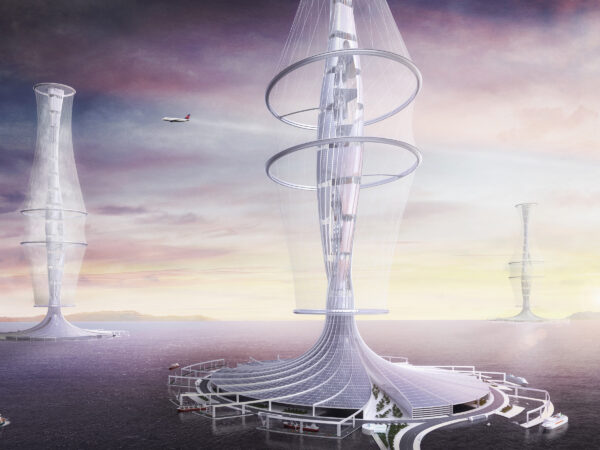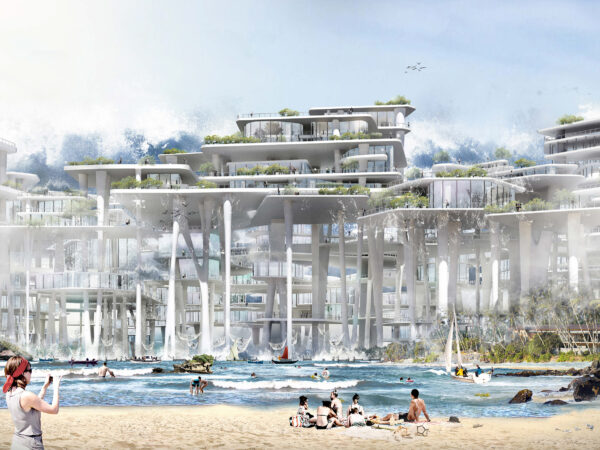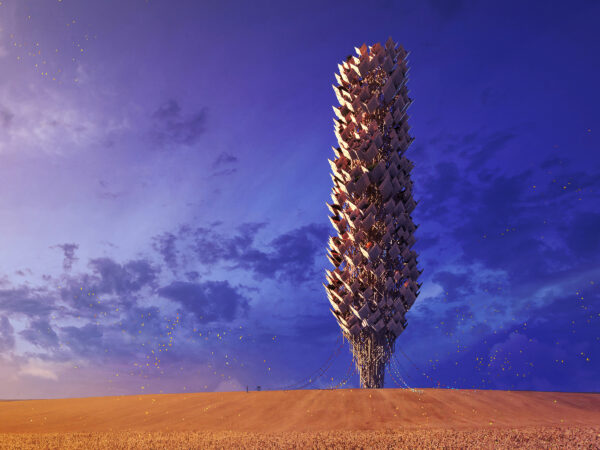eVolo Magazine, tradicional publicação de projetos e design de arquitetura, de qual o blog é parceiro de divulgação, apresenta os projetos ganhadores e menções honrosas do concurso referente a 2022:. eVolo Magazine is pleased to announce the winners of the 2022 Skyscraper Competition. The Jury selected 3 winners and 20 honorable mentions from 427 projects received. The annual award established in 2006 recognizes visionary ideas that through the novel use of technology, materials, programs, aesthetics, and spatial organizations, challenge the way we understand vertical architecture and its relationship with the natural and built environments. The FIRST PLACE was awarded to CLIMATE CONTROL SKYSCRAPER designed by Kim Gyeong Jeung, Min Yeong Gi, and Yu Sang Gu from South Korea. The project investigates the use of a series of skyscrapers to modify weather conditions that would improve the global climate crisis and stop desertification, rising temperatures, and natural disasters. The recipients of the SECOND PLACE are Wang Jue, Zhang Qian, Zhang Changsheng, Li Muchun, and Xu Jing from China for the project TSUNAMI PARK. The project is designed as a man-made inhabited mangrove for the Tonga region to prevent tsunamis that would affect the Pacific Rim. NEW SPRING: AGRO-ECOLOGICAL SKYSCRAPER designed by Michał Spólnik from Austria and Marcin Kitala from Poland received the THIRD PLACE. The proposal is envisioned as an aggregation of garden modules containing distinct flora and microorganisms that could be deployed to specific regions that would flourish with new life. The Jury was formed by Volkan Alkanoglu [Principal, VA | DESIGN], Gianni Botsford [Principal, Gianni Botsford Architects], Steven Chilton [Principal, SCA | Steven Chilton Architects], Tsvetelina Georgieva [Principal, DesignMorphine], Nuru Karim [Principal, Nudes], Arthur Mamou-Mani [Principal, Mamou-Mani Architects], and Moon Hoon [Principal, Moon Hoon Architects]
Climate Control Skyscraper
First Place 2022 Skyscraper Competition Kim Gyeong Jeung, Min Yeong Gi, Yu Sang Gu South Korea  BACKGROUND The two risk factors that will come to mankind over the next decade are “Climate crisis” and “failure to respond to the climate crisis”. 2019 was confirmed as “the Second warmest year in history”. Experts are referring to the end of the Earth as 2050 due to the abnormal climate. From the beginning of the 21st century to 2021, the average temperature of the Earth’s surface rose by 0.93 ±0.07’C, which is more than two-thirds of 1980. (It is increasing by 0.13 degrees to 0.25 degrees every 10 years). Due to the increase in temperature, the global village is currently facing various natural disasters and environmental problems. There are various damages, the most serious damage of climate change to extreme drought and desertification caused by drying up long-term. Of course, reclamation of forests, and man-made factors such as environmental pollution and deforestation have conspired to happen, but desertification due to global climate change is accelerating. Despite these global movements, environmental disasters and desertification around the world are still rising exponentially, and some experts say that environmental problems have already progressed a lot. In other words, awareness and policy on environmental issues are important nationally, but a movement to solve environmental problems through a groundbreaking technological and architectural approach is needed and should be applied worldwide. Then, how can we architecturally prevent desertification as well as persistent natural disasters? The answer lies in the ‘Climate Control Tower’. CCT is designed to cope with climate change and overcome the current climate crisis the world is facing. Through clouds generated by absorbing seawater, the climate crisis regulates the weather by raining where there is a drought, absorbing clouds where heavy rainfalls, or reflecting solar radiation. Read the rest of this entry »
BACKGROUND The two risk factors that will come to mankind over the next decade are “Climate crisis” and “failure to respond to the climate crisis”. 2019 was confirmed as “the Second warmest year in history”. Experts are referring to the end of the Earth as 2050 due to the abnormal climate. From the beginning of the 21st century to 2021, the average temperature of the Earth’s surface rose by 0.93 ±0.07’C, which is more than two-thirds of 1980. (It is increasing by 0.13 degrees to 0.25 degrees every 10 years). Due to the increase in temperature, the global village is currently facing various natural disasters and environmental problems. There are various damages, the most serious damage of climate change to extreme drought and desertification caused by drying up long-term. Of course, reclamation of forests, and man-made factors such as environmental pollution and deforestation have conspired to happen, but desertification due to global climate change is accelerating. Despite these global movements, environmental disasters and desertification around the world are still rising exponentially, and some experts say that environmental problems have already progressed a lot. In other words, awareness and policy on environmental issues are important nationally, but a movement to solve environmental problems through a groundbreaking technological and architectural approach is needed and should be applied worldwide. Then, how can we architecturally prevent desertification as well as persistent natural disasters? The answer lies in the ‘Climate Control Tower’. CCT is designed to cope with climate change and overcome the current climate crisis the world is facing. Through clouds generated by absorbing seawater, the climate crisis regulates the weather by raining where there is a drought, absorbing clouds where heavy rainfalls, or reflecting solar radiation. Read the rest of this entry »
Tsunami Park Skyscraper
Second Place 2022 Skyscraper Competition Wang Jue, Zhang Qian, Zhang Changsheng, Li Muchun, Xu Jing China  People are often afraid of tsunamis. Technological advances have not led to sufficient measures to withstand tsunamis. When a tsunami strikes, people are still helpless. The Pacific Rim, which is linked to all four major tectonic plates, has the highest tsunami rate in the world, with more frequent undersea fluctuations. For example, the volcanic eruption in Tonga on 14 January 2022 resulted in a tsunami threat to the entire Pacific Rim region. It is therefore envisaged that a skyscraper will be built in front of Tonga’s long and narrow coastline. The aim was to reduce the biological and ecological damage caused by the tsunami. We use the edge wave effect of tsunamis to advance the tsunami wave so that the building is in the sea to dissipate it when it has not yet inundated the city. Mangroves are woody plant communities in the intertidal zone of tropical and subtropical coasts, with developed root systems and staggering growth, which have the best effect on tsunami mitigation. Therefore, the skyscraper is inspired by the principle and mechanism of mangrove resistance to tsunamis, and consists of a single unit aggregated to form a vast complex along the coastline. Each cell consists of a bottom pillar and a top multi-level platform. The bottom pillar is made up of thick concrete columns that form a porous structure to dissipate the enormous force of the tsunami, while the upper platforms are of varying sizes, heights, and interconnections to carry people’s lives. Read the rest of this entry »
People are often afraid of tsunamis. Technological advances have not led to sufficient measures to withstand tsunamis. When a tsunami strikes, people are still helpless. The Pacific Rim, which is linked to all four major tectonic plates, has the highest tsunami rate in the world, with more frequent undersea fluctuations. For example, the volcanic eruption in Tonga on 14 January 2022 resulted in a tsunami threat to the entire Pacific Rim region. It is therefore envisaged that a skyscraper will be built in front of Tonga’s long and narrow coastline. The aim was to reduce the biological and ecological damage caused by the tsunami. We use the edge wave effect of tsunamis to advance the tsunami wave so that the building is in the sea to dissipate it when it has not yet inundated the city. Mangroves are woody plant communities in the intertidal zone of tropical and subtropical coasts, with developed root systems and staggering growth, which have the best effect on tsunami mitigation. Therefore, the skyscraper is inspired by the principle and mechanism of mangrove resistance to tsunamis, and consists of a single unit aggregated to form a vast complex along the coastline. Each cell consists of a bottom pillar and a top multi-level platform. The bottom pillar is made up of thick concrete columns that form a porous structure to dissipate the enormous force of the tsunami, while the upper platforms are of varying sizes, heights, and interconnections to carry people’s lives. Read the rest of this entry »
New Spring: Agro-ecological Skyscraper
Third Place 2022 Skyscraper Competition Michał Spólnik, Marcin Kitala Austria, Poland  How would the world be able to feed itself? We live in a paradox – nowadays more food is produced than needed but the expansion of hunger is increasing. How is this possible? Global food production relies greatly on an extremely small number of crop and livestock species. Grains are married to particular chemicals, becoming vulnerable to environmental changes, and lack immunity. Together with changes in how land and water resources are used, population growth, urbanization, and shifting food culture, this lack of crop diversity poses a threat to global food and nutrition security. For the sake of our society – and for the ones to come – we might like to rethink the ways we treat our land. Read the rest of this entry »
How would the world be able to feed itself? We live in a paradox – nowadays more food is produced than needed but the expansion of hunger is increasing. How is this possible? Global food production relies greatly on an extremely small number of crop and livestock species. Grains are married to particular chemicals, becoming vulnerable to environmental changes, and lack immunity. Together with changes in how land and water resources are used, population growth, urbanization, and shifting food culture, this lack of crop diversity poses a threat to global food and nutrition security. For the sake of our society – and for the ones to come – we might like to rethink the ways we treat our land. Read the rest of this entry »
Honorable Mentions
Atenção: Navegação dentro de janela:

